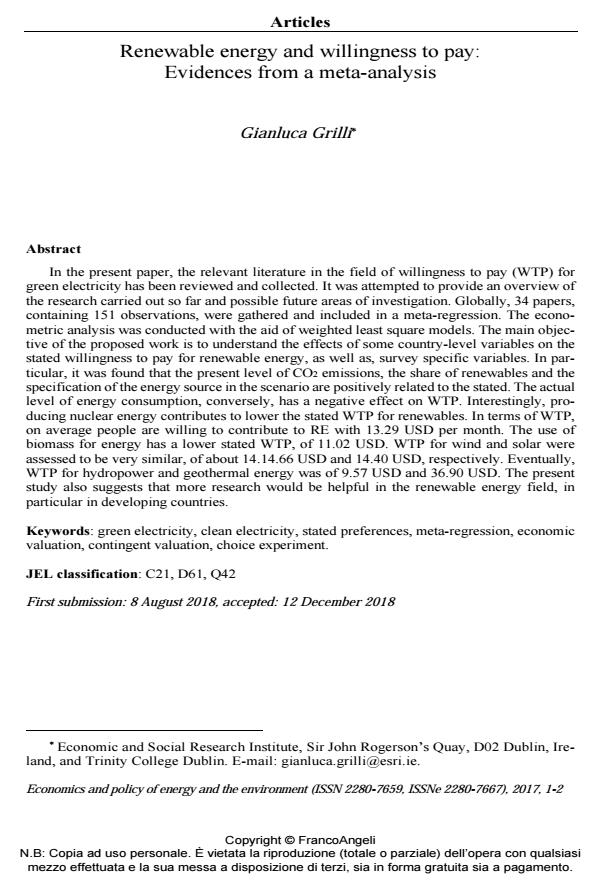Renewable energy and willingness to pay: Evidences from a meta-analysis
Journal title ECONOMICS AND POLICY OF ENERGY AND THE ENVIRONMENT
Author/s Gianluca Grilli
Publishing Year 2017 Issue 2017/1-2
Language English Pages 19 P. 253-271 File size 303 KB
DOI 10.3280/EFE2017-001013
DOI is like a bar code for intellectual property: to have more infomation
click here
Below, you can see the article first page
If you want to buy this article in PDF format, you can do it, following the instructions to buy download credits

FrancoAngeli is member of Publishers International Linking Association, Inc (PILA), a not-for-profit association which run the CrossRef service enabling links to and from online scholarly content.
In the present paper, the relevant literature in the field of willingness to pay (WTP) for green electricity has been reviewed and collected. It was attempted to provide an overview of the research carried out so far and possible future areas of investigation. Globally, 34 papers, containing 151 observations, were gathered and included in a meta-regression. The econometric analysis was conducted with the aid of weighted least square models. The main objective of the proposed work is to understand the effects of some country-level variables on the stated willingness to pay for renewable energy, as well as, survey specific variables. In particular, it was found that the present level of CO2 emissions, the share of renewables and the specification of the energy source in the scenario are positively related to the stated. The actual level of energy consumption, conversely, has a negative effect on WTP. Interestingly, producing nuclear energy contributes to lower the stated WTP for renewables. In terms of WTP, on average people are willing to contribute to RE with 13.29 USD per month. The use of biomass for energy has a lower stated WTP, of 11.02 USD. WTP for wind and solar were assessed to be very similar, of about 14.14.66 USD and 14.40 USD, respectively. Eventually, WTP for hydropower and geothermal energy was of 9.57 USD and 36.90 USD. The present study also suggests that more research would be helpful in the renewable energy field, in particular in developing countries.
Keywords: Green electricity, clean electricity, stated preferences, meta-regression, economic valuation, contingent valuation, choice experiment
Jel codes: C21, D61, Q42
- Pro-Ecological Energy Attitudes towards Renewable Energy Investments before the Pandemic and European Energy Crisis: A Segmentation-Based Approach Alicja Małgorzata Graczyk, Marta Kusterka-Jefmańska, Bartłomiej Jefmański, Andrzej Graczyk, in Energies /2023 pp.707
DOI: 10.3390/en16020707 - The European Market for Guarantees of Origin for Green Electricity: A Scenario-Based Evaluation of Trading under Uncertainty Alexander Wimmers, Reinhard Madlener, in SSRN Electronic Journal /2020
DOI: 10.2139/ssrn.3830442 - Measuring willingness to pay for electricity: The case of New Brunswick in Atlantic Canada Yuri Yevdokimov, Viktor Getalo, Dhirendra Shukla, Tugcan Sahin, in Energy & Environment /2019 pp.292
DOI: 10.1177/0958305X18790954 - The European Market for Guarantees of Origin for Green Electricity: A Scenario-Based Evaluation of Trading under Uncertainty Alexander Wimmers, Reinhard Madlener, in Energies /2023 pp.104
DOI: 10.3390/en17010104 - International evidence on household affordability of deep decarbonization Kang Hua Cao, Yuk-Shing Cheng, Han Qi, Chi-Keung Woo, in Applied Economics Letters /2025 pp.1
DOI: 10.1080/13504851.2025.2564310 - Econometric Studies on the Development of Renewable Energy Sources to Support the European Union 2020–2030 Climate and Energy Framework: A Critical Appraisal Consolación Quintana-Rojo, Fernando-Evaristo Callejas-Albiñana, Miguel-Ángel Tarancón, Isabel Martínez-Rodríguez, in Sustainability /2020 pp.4828
DOI: 10.3390/su12124828 - Developing Applicable Scenarios to Install and Utilize Solar Panels in the Houses of Abu Dhabi City Hamed M. Hussain, Khalil Rahi, Mohammednoor Al Tarawneh, Christopher Preece, in Sustainability /2022 pp.15361
DOI: 10.3390/su142215361 - Household's willingness to pay for renewable electricity: A meta-analysis Yushi Wang, Libo Wu, Yang Zhou, in Energy Economics 107390/2024 pp.107390
DOI: 10.1016/j.eneco.2024.107390
Gianluca Grilli, Renewable energy and willingness to pay: Evidences from a meta-analysis in "ECONOMICS AND POLICY OF ENERGY AND THE ENVIRONMENT" 1-2/2017, pp 253-271, DOI: 10.3280/EFE2017-001013